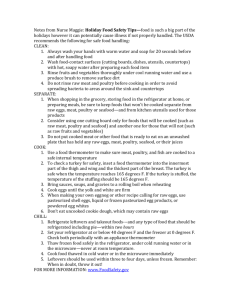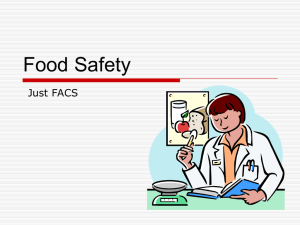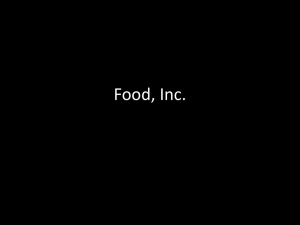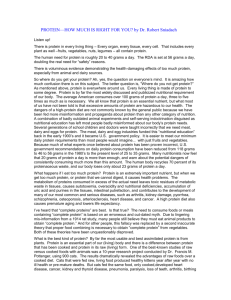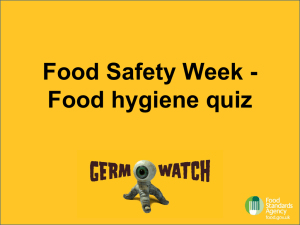Food Safety Tips for Holiday Feasts 2010
advertisement
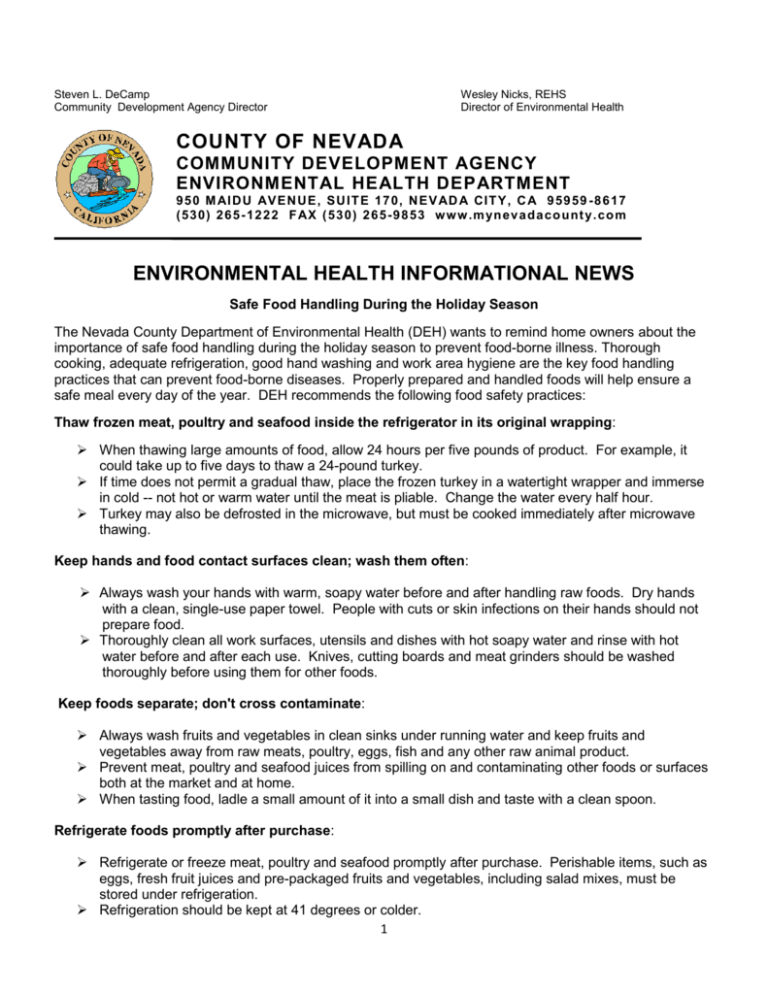
Steven L. DeCamp Community Development Agency Director Wesley Nicks, REHS Director of Environmental Health COUNTY OF NEVADA COMMUNITY DEVELOPMENT AGENCY ENVIRONMENTAL HEALTH DEPARTMENT 95 0 M AI DU AV E N U E , SU IT E 1 7 0, N E V AD A CIT Y , C A 9 59 5 9 - 8 6 17 ( 53 0) 2 6 5 - 12 2 2 F AX ( 53 0) 2 6 5 - 9 8 53 w w w .m yn ev a da co unt y. co m ENVIRONMENTAL HEALTH INFORMATIONAL NEWS Safe Food Handling During the Holiday Season The Nevada County Department of Environmental Health (DEH) wants to remind home owners about the importance of safe food handling during the holiday season to prevent food-borne illness. Thorough cooking, adequate refrigeration, good hand washing and work area hygiene are the key food handling practices that can prevent food-borne diseases. Properly prepared and handled foods will help ensure a safe meal every day of the year. DEH recommends the following food safety practices: Thaw frozen meat, poultry and seafood inside the refrigerator in its original wrapping: When thawing large amounts of food, allow 24 hours per five pounds of product. For example, it could take up to five days to thaw a 24-pound turkey. If time does not permit a gradual thaw, place the frozen turkey in a watertight wrapper and immerse in cold -- not hot or warm water until the meat is pliable. Change the water every half hour. Turkey may also be defrosted in the microwave, but must be cooked immediately after microwave thawing. Keep hands and food contact surfaces clean; wash them often: Always wash your hands with warm, soapy water before and after handling raw foods. Dry hands with a clean, single-use paper towel. People with cuts or skin infections on their hands should not prepare food. Thoroughly clean all work surfaces, utensils and dishes with hot soapy water and rinse with hot water before and after each use. Knives, cutting boards and meat grinders should be washed thoroughly before using them for other foods. Keep foods separate; don't cross contaminate: Always wash fruits and vegetables in clean sinks under running water and keep fruits and vegetables away from raw meats, poultry, eggs, fish and any other raw animal product. Prevent meat, poultry and seafood juices from spilling on and contaminating other foods or surfaces both at the market and at home. When tasting food, ladle a small amount of it into a small dish and taste with a clean spoon. Refrigerate foods promptly after purchase: Refrigerate or freeze meat, poultry and seafood promptly after purchase. Perishable items, such as eggs, fresh fruit juices and pre-packaged fruits and vegetables, including salad mixes, must be stored under refrigeration. Refrigeration should be kept at 41 degrees or colder. 1 ENVIRONMENTAL HEALTH INFORMATIONAL NEWS Cook foods to proper temperatures: Rinse poultry and seafood thoroughly in cold water and drain well before cooking. Always use a meat probe thermometer to ensure that meat is thoroughly cooked: Turkey should be placed immediately in a preheated oven set no lower than 325 degrees. Turkey, other poultry or ground poultry should be cooked to an internal temperature of 165 degrees to kill pathogens (germs) that may be present. To accurately measure the temperature, insert a thermometer in the thickest part of the turkey thigh, but not against the bone. Turkey meat is thoroughly cooked when the hip joint moves easily and the juices run clear, not pink. The National Turkey Federation recommends allowing whole turkeys to stand 10-20 minutes before carving. Stuffing should be cooked separately and heated to an internal temperature of 165 degrees. Beef, veal, and lamb steaks, roasts and chops should be cooked to at least 145 degrees. Ground beef, veal and lamb should be cooked to at least 155 degrees. Pork should be cooked to a minimum internal temperature of 145 degrees. Stuffed meat, poultry and fish and any food stuffed with fish, meat or poultry should be heated to a minimum internal temperature of 165 degrees. Eggs and foods containing raw eggs should be cooked to a minimum internal temperature of 145 degrees. When leftovers are eaten hot, they should be re-heated to at least 165 degrees or until hot and steaming throughout. Cooking times in microwaves may vary because ovens vary in power and efficiency: Cooking whole, stuffed poultry in a microwave is not recommended. Foods cooked or reheated in microwaves should be stirred or turned occasionally to ensure that all parts of the food are thoroughly cooked and allowed to finish cooking at least 5 minutes after microwaving before consuming. If cooking frozen meat, first microwave the meat until completely thawed, then follow by cooking. If microwaving is not possible, then allow at least an additional one-and-a-half times the usual cooking time to ensure that the meat is sufficiently cooked throughout. Refrigerate leftovers: Turkey should be refrigerated after cooking in one of two ways: Within two hours after it is cooked; or right after cooking, the turkey should be de-boned, sliced or pulled into pieces no more than 2 1/2 inches thick and refrigerated in shallow containers. Store the meat, stuffing and stock in separate containers in the refrigerator or freezer. Do not eat leftover meat that has been refrigerated for longer than four days or leftover stuffing or gravy refrigerated for longer than two days. If properly wrapped, leftover meat may be safely consumed after being frozen for one to three months. Resources for information on food safety include the Federal Food and Drug Administration Food Information Hotline at (888) SAFE FOOD and the U.S. Department of Agriculture Meat and Poultry Hotline at (800) 535-4555 or www.fsis.usda.gov. Consumers can also access the national Partnership for Food Safety Education's "Fight BAC" (bacteria) Web page at www.fightbac.org/. 2
